
The Continuation War, also known as the Second Soviet-Finnish War, was a conflict fought by Finland and Nazi Germany against the Soviet Union during World War II. It began with a Finnish declaration of war and invasion on 25 June 1941 and ended on 19 September 1944 with the Moscow Armistice. The Soviet Union and Finland had previously fought the Winter War from 1939 to 1940, which ended with the Soviet failure to conquer Finland and the Moscow Peace Treaty. Numerous reasons have been proposed for the Finnish decision to invade, with regaining territory lost during the Winter War regarded as the most common. Other justifications for the conflict include Finnish President Risto Ryti's vision of a Greater Finland and Commander-in-Chief Carl Gustaf Emil Mannerheim's desire to annex East Karelia.

The Winter War was a war between the Soviet Union and Finland. It began with a Soviet invasion of Finland on 30 November 1939, three months after the outbreak of World War II, and ended three and a half months later with the Moscow Peace Treaty on 13 March 1940. Despite superior military strength, especially in tanks and aircraft, the Soviet Union suffered severe losses and initially made little headway. The League of Nations deemed the attack illegal and expelled the Soviet Union.
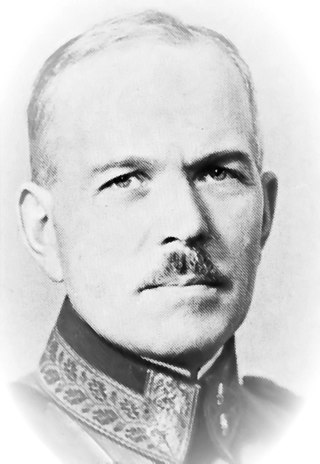
Karl Lennart Oesch was one of Finland's leading generals during World War II. He held a string of high staff assignments and front commands, and at the end of the Continuation War commanded three Finnish army corps on the Karelian Isthmus. He received numerous awards, including the Finnish Mannerheim Cross during his service. Following the end of the Continuation War, he was tried and convicted for war crimes relating to the treatment of Soviet prisoners-of-war.
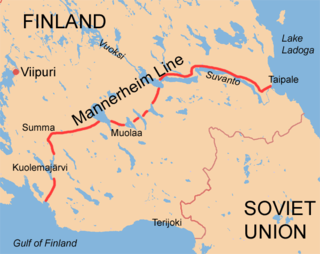
The Mannerheim Line was a defensive fortification line on the Karelian Isthmus built by Finland against the Soviet Union. While this was never an officially designated name, during the Winter War it became known as the Mannerheim Line, after Finnish Army's then commander-in-chief Field Marshal Baron Carl Gustaf Emil Mannerheim. The line was constructed in two phases: 1920–1924 and 1932–1939. By November 1939, when the Winter War began, the line was by no means complete.
The II Corps was a unit of the Finnish Army during the Winter War.

Solovyovo, formerly Taipale, is a rural locality in Priozersky District of Leningrad Oblast, Russia, located on the western shore of Lake Ladoga on the Karelian Isthmus about 80 kilometers (50 mi) north of Saint Petersburg. The settlement is approximately 100 kilometers (62 mi) east-southeast of the post-Winter War border with Finland. Vuoksi River's southern armlet Burnaya empties into Lake Ladoga at Solovyovo. As of January 1997, its population was 7.
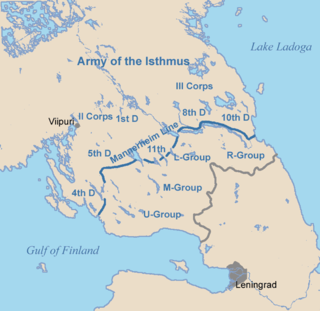
The Army of the Isthmus was a formation of the Finnish Army during the Winter War. It was stationed on the Karelian Isthmus and was the largest formation of the Finnish Army, as it was charged to defend the important isthmus.
The IV Corps was a formation of the Finnish Army during the Winter War against the Soviet Union. It defended the area north of Lake Ladoga against Soviet attacks. It was commanded by Major General Juho Heiskanen and from 4 December 1939 by Major General Woldemar Hägglund. The IV Corps defeated superior Soviet troops by using motti tactics.
The III Corps was a unit of the Finnish Army during the Winter War. The III Corps with the II Corps formed the Army of the Isthmus. For most of the war it defended the Mannerheim Line on the northern side of the River Vuoksi against Soviet attacks.

The Vyborg–Petrozavodsk offensive or Karelian offensive was a strategic operation by the Soviet Leningrad and Karelian Fronts against Finland on the Karelian Isthmus and East Karelia fronts of the Continuation War, on the Eastern Front of World War II. The Soviet forces captured East Karelia and Vyborg/Viipuri. After that, however, the fighting reached a stalemate.

The Battle of Ilomantsi was a part of the Svir–Petrozavodsk Offensive of the Continuation War (1941–1944). It was fought from 26 July to 13 August 1944, between Finland and the Soviet Union in an area roughly 40 kilometers wide and 30 kilometers deep, near the Finnish-Soviet border, close to the Finnish village of Ilomantsi, in North Karelia. The battle ended with a Finnish victory—the last major Soviet attack against Finland was stopped here.

The Battle of Raate Road was a battle fought during the Winter War between the Soviet Union and Finland in January 1940, as a part of the Battle of Suomussalmi.
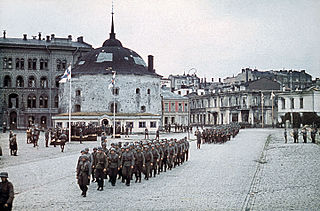
The Finnish invasion of the Karelian Isthmus refers to a military campaign carried out by Finland in 1941. It was part of what is commonly referred to as the Continuation War. Early in the war Finnish forces liberated the Karelian Isthmus. It had been ceded to the Soviet Union on 13 March 1940, in the Moscow Peace Treaty, which marked the end of the Winter War. Later, in the summer of 1944, the Soviet Union reconquered the southern part of the isthmus in the Vyborg–Petrozavodsk Offensive.
The 8th Army was a field army of the Soviet Red Army during the Second World War.
The timeline of the Winter War is a chronology of events leading up to, culminating in, and resulting from the Winter War. The war began when the Soviet Union attacked Finland on 30 November 1939 and it ended 13 March 1940.
The aftermath of the Winter War covers the historical events and views following the Winter War between Finland and the Soviet Union from 30 November 1939 to 13 March 1940.

The North Finland Group was a formation of the Finnish Army during the Winter War. It was responsible for an almost 800-kilometer-long border from the town of Lieksa to the Arctic Ocean. The group was under the command of Major General Wiljo Tuompo, and its headquarters was located in Kajaani.
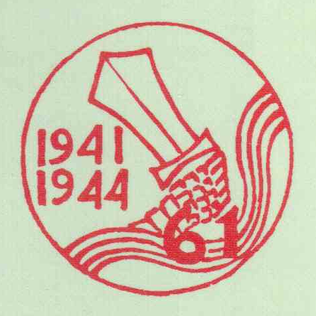
The Finnish 61st Infantry Regiment (IR61) was a combat regiment of the 17th division of the Finnish Army during the Second World War, consisting almost exclusively of Swedish-speaking Finns. Among others, the regiment participated in the battle of Tienhaara. The regiment has been the subject of several books, as well as a feature film Beyond the Front Line. In 1980, Lieutenant general A. E. Martola opined: "Honestly, this regiment saved Finland during the midsummer weekend 1944, even if only temporarily."
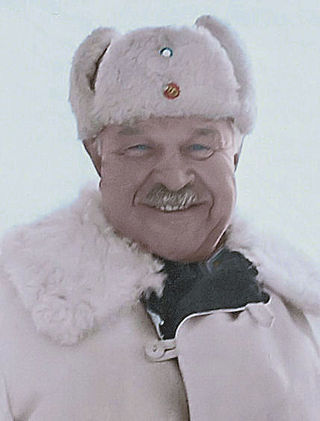
Taavetti Laatikainen was a Finnish General of Infantry and a member of the Jäger movement. He fought in the Eastern Front of World War I, the Finnish Civil War, the Winter War and the Continuation War. During the last of these, he was awarded the Mannerheim Cross of Liberty 2nd Class. Before the Winter War, he commanded both the Reserve Officer School and the Officer Cadet School. He retired in 1948 from the position of Inspector of Infantry.
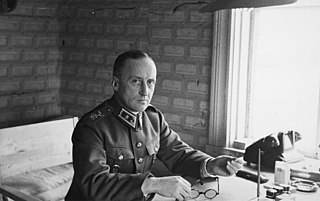
Aarne Leopold Blick was a Finnish lieutenant general, Knight of the Mannerheim Cross and a member of the Jäger movement. He participated in the Eastern Front of World War I, the Finnish Civil War, the Winter War and the Continuation War.
















